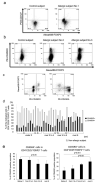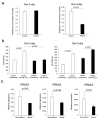Surface Phenotype Changes and Increased Response to Oxidative Stress in CD4+CD25high T Cells
- PMID: 34072455
- PMCID: PMC8229188
- DOI: 10.3390/biomedicines9060616
Surface Phenotype Changes and Increased Response to Oxidative Stress in CD4+CD25high T Cells
Abstract
Conversion of CD4+CD25+FOXP3+ T regulatory cells (Tregs) from the immature (CD45RA+) to mature (CD45RO+) phenotype has been shown during development and allergic reactions. The relative frequencies of these Treg phenotypes and their responses to oxidative stress during development and allergic inflammation were analysed in samples from paediatric and adult subjects. The FOXP3lowCD45RA+ population was dominant in early childhood, while the percentage of FOXP3highCD45RO+ cells began increasing in the first year of life. These phenotypic changes were observed in subjects with and without asthma. Further, there was a significant increase in phosphorylated ERK1/2 (pERK1/2) protein in hydrogen peroxide (H2O2)-treated CD4+CD25high cells in adults with asthma compared with those without asthma. Increased pERK1/2 levels corresponded with increased Ca2+ response to T cell receptor stimulation. mRNA expression of peroxiredoxins declined in Tregs from adults with asthma. Finally, CD4+CD25high cells from paediatric subjects were more sensitive to oxidative stress than those from adults in vitro. The differential Treg sensitivity to oxidative stress observed in children and adults was likely dependent on phenotypic CD45 isoform switching. Increased sensitivity of Treg cells from adults with asthma to H2O2 resulted from a reduction of peroxiredoxin-2, -3, -4 and increased pERK1/2 via impaired Ca2+ response in these cells.
Keywords: CD45 isoform; allergy; extracellular signal-regulated kinases 1/2; oxidative stress; regulatory T cell.
Conflict of interest statement
The authors declare no conflict of interest.
Figures




Similar articles
-
A modified flow cytometry method for objective estimation of human CD4+ regulatory T cells (CD4+ Tregs) in peripheral blood, via CD4/CD25/CD45RO/FoxP3 labeling.Cytometry B Clin Cytom. 2020 May;98(3):259-269. doi: 10.1002/cyto.b.21841. Epub 2019 Sep 30. Cytometry B Clin Cytom. 2020. PMID: 31571372
-
Role of regulatory CD4+CD25+ Foxp3 T cells in bronchial asthma in Egyptian children.Egypt J Immunol. 2013;20(2):29-38. Egypt J Immunol. 2013. PMID: 24617045
-
Analysis of FOXP3+ regulatory T cell subpopulations in peripheral blood and tissue of patients with systemic lupus erythematosus.Immunol Res. 2017 Apr;65(2):551-563. doi: 10.1007/s12026-017-8904-4. Immunol Res. 2017. PMID: 28224362
-
Multiple sclerosis patients have reduced resting and increased activated CD4+CD25+FOXP3+T regulatory cells.Sci Rep. 2021 May 18;11(1):10476. doi: 10.1038/s41598-021-88448-5. Sci Rep. 2021. PMID: 34006899 Free PMC article.
-
Different phenotypes of CD4+CD25+Foxp3+ regulatory T cells in recipients post liver transplantation.Int Immunopharmacol. 2019 Apr;69:194-201. doi: 10.1016/j.intimp.2019.01.048. Epub 2019 Feb 5. Int Immunopharmacol. 2019. PMID: 30735938
Cited by
-
Impaired response of memory Treg to high density lipoproteins is associated with intermediate/high cardiovascular disease risk in persons with HIV.Front Immunol. 2023 Mar 10;14:1146624. doi: 10.3389/fimmu.2023.1146624. eCollection 2023. Front Immunol. 2023. PMID: 36969259 Free PMC article.
-
Increased SOAT2 expression in aged regulatory T cells is associated with altered cholesterol metabolism and reduced anti-tumor immunity.Nat Commun. 2025 Jan 13;16(1):630. doi: 10.1038/s41467-025-56002-w. Nat Commun. 2025. PMID: 39805872 Free PMC article.
References
-
- Akdis M., Verhagen J., Taylor A., Karamloo F., Karagiannidis C., Crameri R., Thunberg S., Deniz G., Valenta R., Fiebig H., et al. Immune Responses in Healthy and Allergic Individuals Are Characterized by a Fine Balance between Allergen-Specific T Regulatory 1 and T Helper 2 Cells. J. Exp. Med. 2004;199:1567–1575. doi: 10.1084/jem.20032058. - DOI - PMC - PubMed
Grants and funding
LinkOut - more resources
Full Text Sources
Research Materials
Miscellaneous

